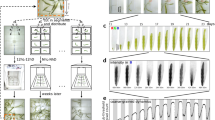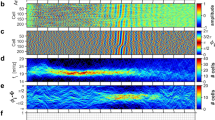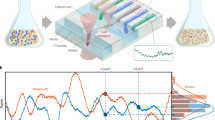Abstract
SYNCHRONOUS cultures (populations of algae in which cell divisions and interphase preparations for division are phased or synchronized) are often used in studies of the algal life-cycle. The devices and methods used to obtain synchronous cultures of algae are as a rule rather complicated1–3, so we developed a device of simple construction, the parts of which are easy to obtain. To synchronize the cultures we chose the method in which a random culture is subjected to a regular alternation of light and dark periods of adequate duration.
This is a preview of subscription content, access via your institution
Access options
Subscribe to this journal
Receive 51 print issues and online access
$199.00 per year
only $3.90 per issue
Buy this article
- Purchase on Springer Link
- Instant access to full article PDF
Prices may be subject to local taxes which are calculated during checkout
Similar content being viewed by others
References
Lorenzen, H. in Synchrony in Cell Division and Growth (edit. by Zeuthen, E.) (Interscience, New York, 1964).
Tamiya, H., and Morimura, Y. in Synchrony in Cell Division and Growth (edit. by Zeuthen, E.) (Interscience, New York, 1964).
Tamiya, H., Morimura, Y., Yokota, M., and Kunieda, R., Plant and Cell Physiol., 2, 383 (1961).
Rodhe, W., Symb. Bot. Ups., 10 (1) 1 (1948).
Author information
Authors and Affiliations
Rights and permissions
About this article
Cite this article
LAFEBER, A., STEENBERGEN, C. Simple Device for obtaining Synchronous Cultures of Algae. Nature 213, 527–528 (1967). https://doi.org/10.1038/213527a0
Issue Date:
DOI: https://doi.org/10.1038/213527a0
This article is cited by
-
Obtaining Synchronous Cultures of Algae
Nature (1968)
-
Obtaining Synchronous Cultures of Algae
Nature (1968)
Comments
By submitting a comment you agree to abide by our Terms and Community Guidelines. If you find something abusive or that does not comply with our terms or guidelines please flag it as inappropriate.



